Structure of a spiral galaxy
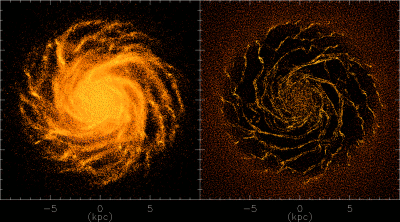
|
|
Stellar (left) and gas (right) density maps of a simulated galaxy
similar in size to M33.
We study how star formation
is associated with gas and stellar spiral patterns,
and how supernovae regulate and/or induce star formation in the disc.
|
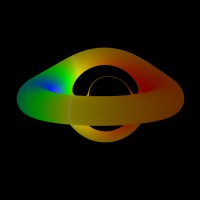
|
Relativistic accretion torus around a Kerr black hole
Rendering of a relativistic accretion torus
around a Kerr (rotating) black hole
[ Fuerst & Wu, 2004, A&A, 424, 733].
Emissions from the accretion torus suffer frequency shifts,
caused by relative motion between the emitting particles and the observer,
time dilation
(as a consequence of transverse motion of the emitters
and photons climbing the deep gravitational potential)
and dragging of space-time by the rotating black hole.
The emission is also gravitationally lensed.
Areas of the torus image are coloured to indicate the frequency shifts:
red marks the torus surface elements where the emission is redshifted
(lengthened wavelength);
blue areas where the emission is blueshifted (shortened wavelength).
Secondary and tertiary order images of the torus
appear through the central gap in the principal image.
These occur where light rays bend around the hole
once, twice and multiple times before reaching the observer.
|
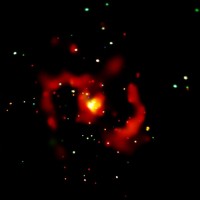
|
X-ray sources in the galaxy M83
X-ray colour image of the nuclear starburst galaxy M83,
obtained with the Chandra X-ray telescope
[ Soria & Wu 2003, A&A 410, 53].
Colours are: red for the 0.3–1 keV
band; green for 1–2 keV;
blue for 2-8 keV.
Diffuse X-ray emitting gas traces the star-forming regions:
the spiral arms, where the gas is cooler (kT ~ 0.3 keV),
and the nuclear region, where it is hotter (kT ~ 0.7 keV).
More than 100 point-like X-ray sources are detected,
scattered across the galactic disk:
most of them are neutron star X-ray binaries;
in addition, there are a few accreting black holes
and some white dwarfs with ongoing nuclear burning on their surface.
|
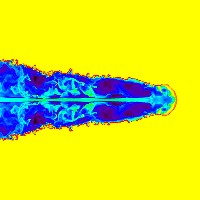
|
Bow-shock of a radiative jet
The jet emerging from the nucleus of an active galaxy
drives a bow-shock in the interstellar medium (ISM).
If the latter is sufficiently dense
and the jet power low enough,
then radiative cooling affects the dynamics
of the bow-shock and the jet's advance.
In this 2D density map from a computer simulation
a jet (cyan, originating in the middle of the left border)
drills through a uniform ISM (yellow),
filling a cocoon with jet-derived plasma (blue).
The bow shock is strongly radiative and thermally unstable,
collapsing to a thin dense layer (red)
at the contact discontinuity between cocoon plasma and ISM.
Dense knots on this shell may detach as free-floating clouds,
like the the narrow-line region (NLR) clouds of a Seyfert galaxy.
|
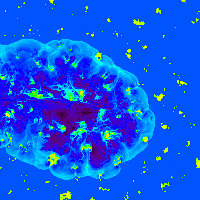
|
Jet disruption in a cloudy interstellar medium
Encounters with dense interstellar clouds can deflect or disrupt
the jet from even the most powerful active galactic nucleus (AGN).
This 2D density map shows a simulated jet
(originating at centre of left border)
hitting several clouds (initially yellow) before it loses collimation
[ Saxton et al. 2005, MNRAS 359, 781].
The jet-driven bow-shock (cyan outer surface)
encompasses a high-pressure region
that crushes clouds entering it.
Some clouds collapse and persist with strongly radiative shocks (red).
Others, of lighter density
or greater exposure to intra-cocoon turbulence,
suffer effectively adaiabatic shocks,
and ablate rapidly.
The association of shocked, line-emitting clouds
and a jet with disrupted, frustrated radio morphology
is a model for GPS (gigahertz-peaked spectrum) sources,
where the activity is confined within the galaxy's central kiloparsecs.
|
![]() +44 (0)1483 204100 - Copyright © 1999–2006 UCL
+44 (0)1483 204100 - Copyright © 1999–2006 UCL